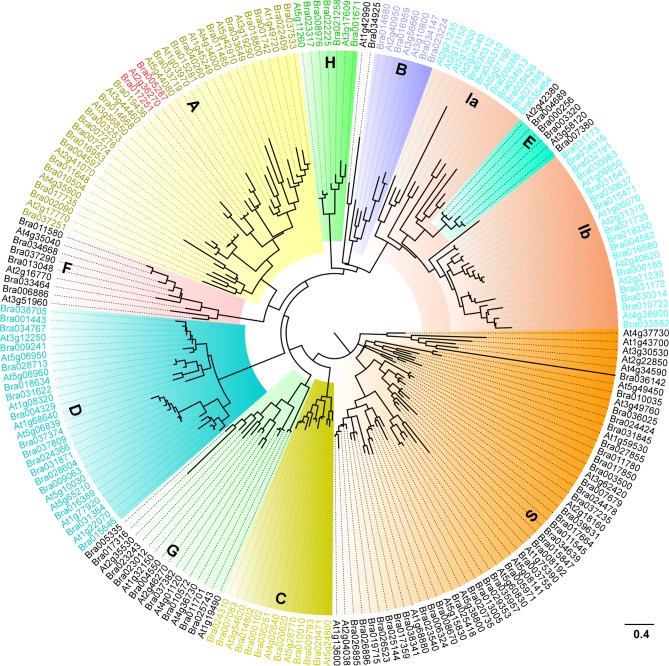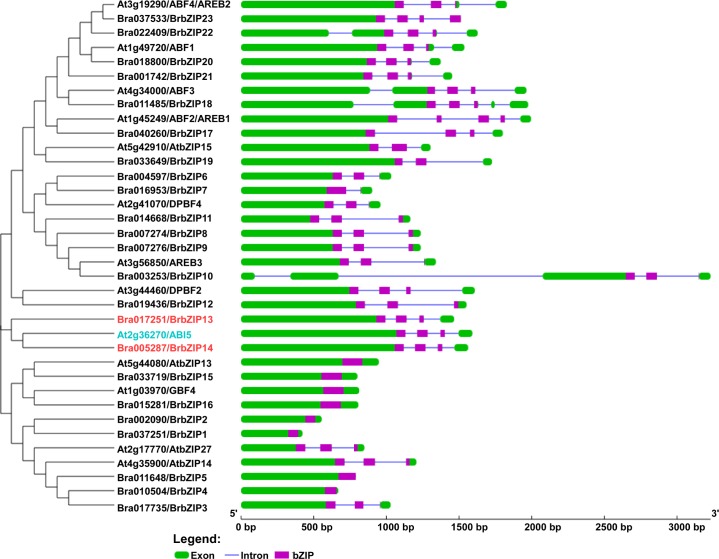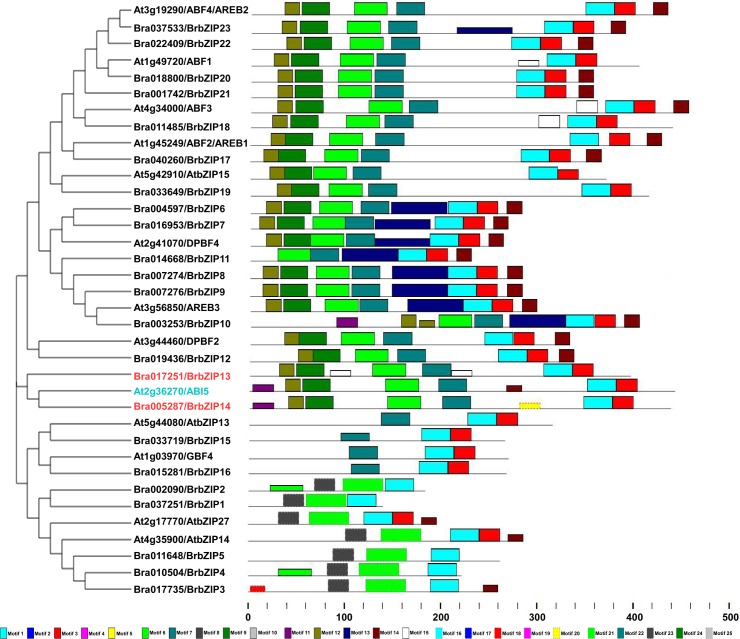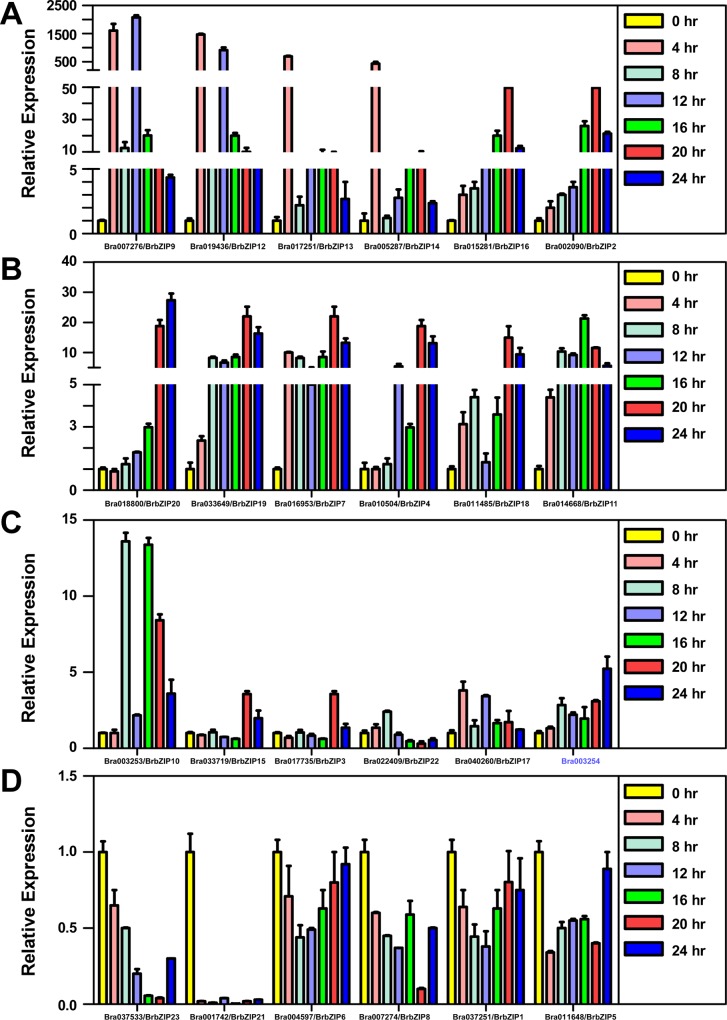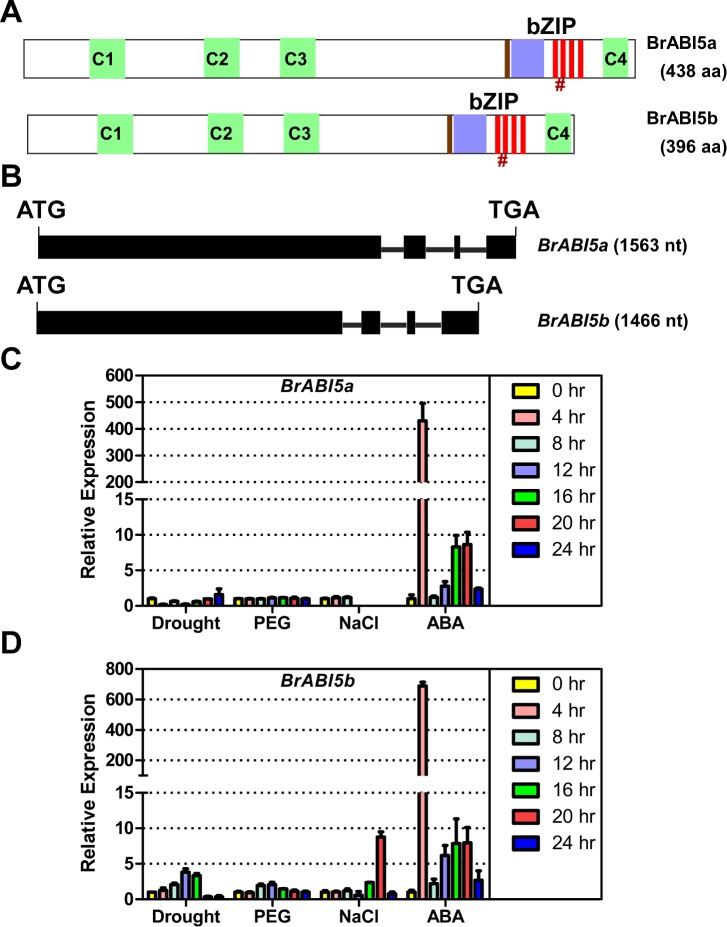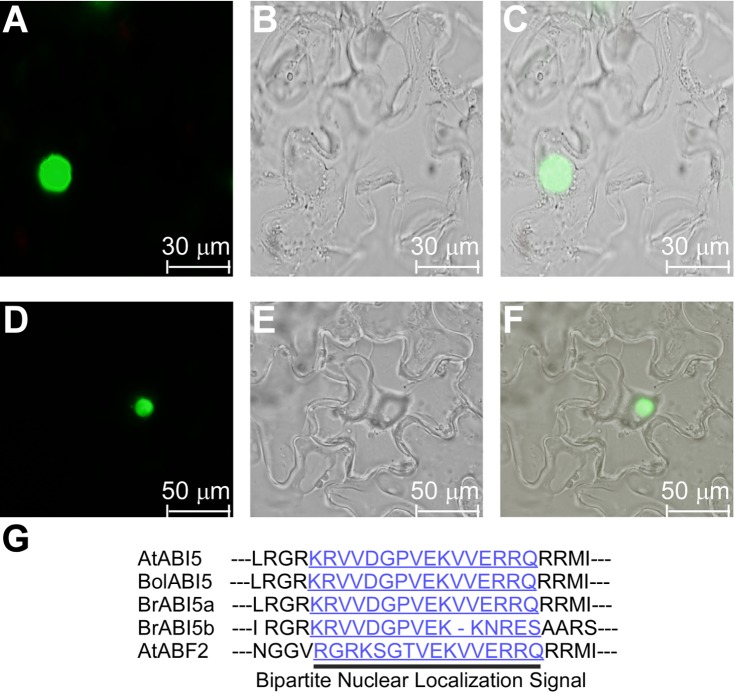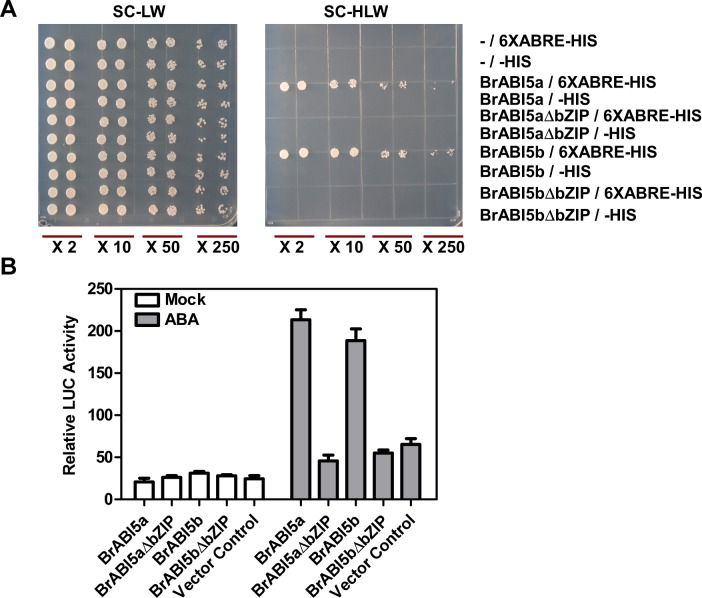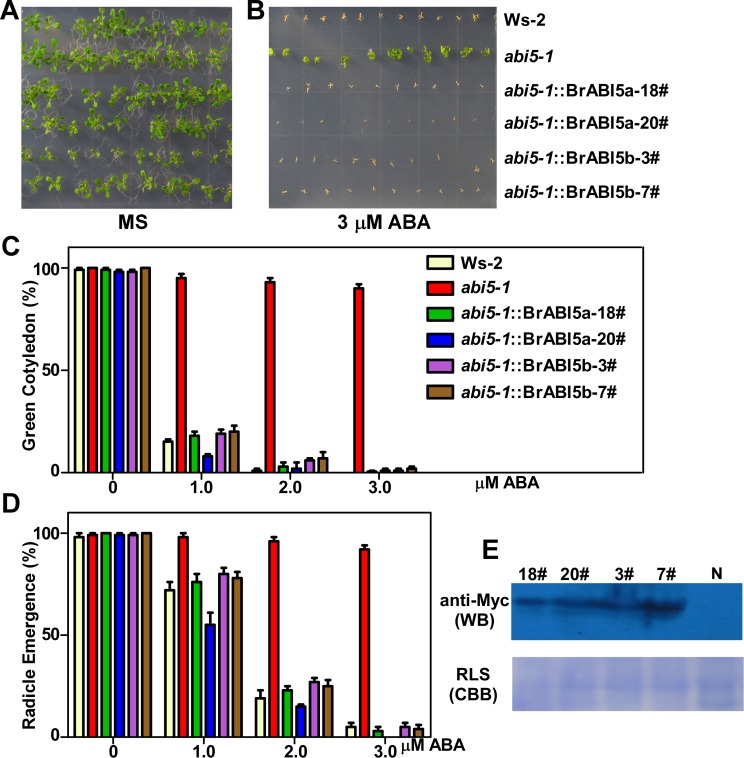Abstract
bZIP (basic leucine zipper) transcription factors coordinate plant growth and development and control responses to environmental stimuli. The genome of Chinese cabbage (Brassica rapa) encodes 136 putative bZIP transcription factors. The bZIP transcription factors in Brassica rapa (BrbZIP) are classified into 10 subfamilies. Phylogenetic relationship analysis reveals that subfamily A consists of 23 BrbZIPs. Two BrbZIPs within subfamily A, Bra005287 and Bra017251, display high similarity to ABI5 (ABA Insensitive 5). Expression of subfamily A BrbZIPs, like BrABI5a (Bra005287/BrbZIP14) and BrABI5b (Bra017251/BrbZIP13), are significantly induced by the plant hormone ABA. Subcellular localization assay reveal that both BrABI5a and BrABI5b have a nuclear localization. BrABI5a and BrABI5b could directly stimulate ABA Responsive Element-driven HIS (a HIS3 reporter gene, which confers His prototrophy) or LUC (LUCIFERASE) expression in yeast and Arabidopsis protoplast. Deletion of the bZIP motif abolished BrABI5a and BrABI5b transcriptional activity. The ABA insensitive phenotype of Arabidopsis abi5-1 is completely suppressed in transgenic lines expressing BrABI5a or BrABI5b. Overall, these results suggest that ABI5 orthologs, BrABI5a and BrABI5b, have key roles in ABA signalling in Chinese cabbage.
Introduction
Cooperation between transcription factors and the core transcription enzyme, RNA polymerase, initiates gene expression in eukaryote organisms. Transcription factors comprise approximately 3.5–7.0% of the genome [1]. The plant genome has a number of transcription factors families, such as MYB, AP2, bHLH, WRKY, NAC, and MADS [2]. The bZIP (Basic Leucine Zipper) family is one of the largest and most diverse transcription factor families in plants [3,4]. All bZIP family members share a highly conserved domain, which contains a basic region and a Leu zipper, known as the bZIP domain. The basic region contains a N-x7-R/K-x9 motif that directly binds to DNA and determines its nuclear localization. The leucine zipper forms an amphipathic surface, which plays an important role in bZIP transcription factors dimerization [3,4,5]. In addition, bZIP transcription factors have other conserved motifs besides the bZIP domain to modulate their transcriptional activity [3,5]. For example, phosphorylation of a conserved Ser or Thr in the R-X-X-S/T motif in many subfamily A bZIP factors activates target gene expression [6,7,8,9].
In Arabidopsis, 13 bZIP factors are divided into subfamily A, which includes ABI5 (ABA Insensitive 5) and ABFs (Abcisic Acid Responsive Element Binding Factors), also known as AREBs (ABA-Responsive Element Binding Proteins) [3]. ABI5 and ABFs have crucial roles to activate plant ABA (Abcisic Acid) signalling [10,11,12,13,14,15,16,17,18]. In addition, post-translational modifications fine-tune ABI5- and ABF-like bZIP transcription factors signalling through cellular processes, such as phosphorylation [6,7,8,14,19,20,21], ubiquitination-mediated protein stability [19,22,23,24], sumolation [25], and S-nitrosylation [26]. In the past decade, a number of ABI5- or ABF-like bZIP transcription factors in other plant species have been characterized, such as HvABI5 from barley [27] and OsABF1, OsABF2, and OsABI5 from rice [28,29,30,31,32], VvABF2 from grape (Vitis vinifera) [33], and BolABI5 from cabbage (Brassica oleracea)[9]. As expected, many ABI5- or ABF-like bZIP transcription factors demonstrate a pivotal role in ABA responses [9,27,28,29,30,31,32,33].
A number of bZIP factors have been identified in plant genomes, such as 75 bZIP genes in Arabidopsis [3], 89 in rice [4], 88 in Sorghum [1],125 in maize [34], 100 in castor bean [35], 64 in cucumber [36], 55 in grapevine [5], 89 in Barley [37] and 96 in grass (Brachypodium distachyon) [38]. Chinese cabbage (Brassica rapa) is a dominant vegetable crop consumed in northern China during winter [39,40]. Recently, a total of 136 bZIP factors have been annotated in Brassica rapa [41].
So far, few bZIPs have been characterized in Brassica rapa [41,42,43] and its relatives, Brassica oleracea [9], Brassica napus (oil rape) [44,45,46] and Brassica juncea [47]. Moreover, it is still unknown whether the subfamily A BrbZIPs (the bZIP factors in Brassica rapa) modulate ABA responses. To understand the evolutionary relationship among bZIP transcription factors in Brassica rapa, we constructed a phylogenetic tree and classified them [1,3,4,5,35,36,37,38]. In addition, we characterized two ABI5-like BrbZIPs, BrABI5a (Bra005287/BrbZIP14) and BrABI5b (Bra017251/BrbZIP13).
Materials and Methods
Protein Properties and Phylogenetic Analysis
To verify the bZIP domain in putative BrbZIPs[41], online tools such as to search for conserved domains within a protein or coding nucleotide sequence (http://www.ncbi.nlm.nih.gov/Structure/cdd/wrpsb.cgi) [48], SMART (Simple Modular Architecture Research Tool, http://smart.embl-heidelberg.de/), Pfam (http://pfam.xfam.org/) and HMMER (Profile hidden Markov models for biological sequence analysis, http://www.ebi.ac.uk/Tools/hmmer/) were used to perform bZIP domain predictions. Proteins which showed the presence of bZIP domain with confidence (E-value <1.0) were selected for further analysis.
The molecular weight (kDa) and isoelectric point (pI) of BrbZIPs were calculated by DNAstar. The conserved motifs and protein architecture were predicted by the MEME (Multiple Em for Motif Elicitation) tool (http://meme-suite.org/tools/meme) with parameters set: optimum motif width ≥6 and ≤200, maximum number of motifs 25 as previously described [35]. All AtbZIPs and BrbZIPs were aligned with the MUSCLE tool and the maximum likelihood trees were generated using MEGA 5.0 as previously described [9,35,49,50].
Chromosome Location and Intron/Exon Organization of BrbZIP Genes
The physical positional information of each BrbZIPs genes was downloaded from the Brassica rapa database (BRAD, http://brassicadb.org/brad/index.php). Locations of BrbZIP genes on Brassica rapa chromosomes were then deciphered with MapChart 2.2 tool (http://www.wageningenur.nl/en/show/Mapchart.htm)[51].
The CDSs (coding sequences) of the BrbZIP genes were also downloaded from Brassica rapa database (BRAD, http://brassicadb.org/brad/index.php). The CDSs of the BrbZIP genes were used as the queries for local BLAST to search against the whole genome assembly of Brassica rapa (B.rapa_Chromosome_V1.5). The genomic sequences of BrbZIP genes were then retrieved. The online Gene Structure Display Server (GSDS2.0, http://gsds.cbi.pku.edu.cn/) [52] was used to decipher the architectures of BrbZIP genes.
qRT-PCR (Real-Time Quantitative RT-PCR) Analysis
Total RNA was extracted from samples after treatments with TRIzol reagent (TaKaRa). Total RNA was then treated with RNase-free DNase (TaKaRa) to remove DNA, and used for reverse transcription with PrimeScript™ RT Master Mix (Perfect Real Time, TaKaRa). Then, real-time qRT-PCR was performed using a CFX96 real-time PCR machine (Bio-Rad, Hercules, CA, USA) and SYBR Premix Ex Taq kit (TaKaRa) to monitor double-stranded DNA products as previously described [8,9,49,50]. Data from real-time PCR was analyzed by the software (Bio-Rad CFX Manager) and the standard curve method (delta‐delta ct value) was used for calculating the relative expression of experimental genes normalized to the expression of cabbage ACTIN2 (BrACTIN2/Bra037560) according to the manufacturer’s instructions. The primers used for qRT-PCR are listed online in S1 Table.
Plasmid Construction
To construct Myc-tagged BrABI5a and Myc-tagged BrABI5b, full-length CDSs were amplified via RT-PCR at first. The sequence-confirmed, full-length CDSs of BrABI5a and BrABI5b were then cloned into BamHⅠ and SalⅠ sites of the binary vector p1307-6Myc as previously described [8,9,49,50].
To make GFP-tagged BrABI5a and BrABI5b (BrABI5a-GFP and BrABI5b-GFP), the CDSs were removed from p1307-6Myc-BrABI5a and p1307-6Myc-BrABI5b and then inserted into the Cam-35S-GFP vector between the BamHⅠ and SalⅠsites, resulting in a C-terminal fusion to GFP.
To express BrABI5a and BrABI5b in yeast, the CDSs of BrABI5a and BrABI5b were cloned into the pPC86 vector between SalⅠ and EcoRⅠ sites as previously described [8,9]. To delete the bZIP motif on BrABI5a and BrABI5b, we truncated BrABI5a (1–352 aa, BrABI5aΔbZIP) and BrABI5b (1–310 aa, BrABI5bΔbZIP) via PCR amplification. The products BrABI5aΔbZIP and BrABI5bΔbZIP were also inserted into the pPC86 vector between SalⅠ and EcoRⅠ sites respectively. The primers used to construct the plasmids are listed online in S2 Table. All plasmids were confirmed by sequencing to avoid cloning errors.
Subcellular Localization
The Cam-35S-BrABI5a-GFP and Cam-35S-BrABI5b-GFP vectors were introduced into the Agrobacterium tumefaciens strain GV3101 and then infiltrated into 5- to 6-week-old Nicotiana benthamiana leaves for transient expression as previously described [9,53]. The Agrobacterium strains were infiltrated at an OD600 of 0.5. For microscopic analyses, leaf discs were cut 3 days after infiltration. Cells from the lower epidermis were analyzed at room temperature with 20% glycine as the imaging medium. GFP-fluorescence signals were examined under an inverted Zeiss LSM 510 META fluorescence confocal microscope.
Yeast One-Hybrid Assay
The yeast strain yWAM2 was used to perform a yeast one-hybrid assay. Yeast transformation and growth assays were performed according to the Yeast Protocols Handbook provided by Clontech. Briefly, pPC86-BrABI5a or pPC86-BrABI5b or pPC86-BrABI5aΔbZIP or pPC86-BrABI5bΔbZIP combined with either pRS315-6×ABRE-HIS or pRS315-HIS were transformed into the yeast strain yWAM2 with the lithium acetate/single-stranded carrier DNA/polyethylene glycol method. The transformed yeast cells were selected on synthetic complete medium lacking leucine and tryptophan (SC-LW). DNA binding and transactivation were determined by measuring the growth of serial dilutions of transformed yeast cells on synthetic complete medium lacking leucine, tryptophan and histidine (SC-LWH) for 2–3 days. All of these were performed as previously described [8,9].
Transactivation Activity of BrABI5a and BrABI5b In Vivo
To detect the transactivation activity of BrABI5a and BrABI5b in planta, the pEM6-fLUC reporter system was recruited as previously described [8]. The p1307-6Myc-BrABI5a, p1307-6Myc-BrABI5b, p1307-6Myc-BrABI5aΔbZIP and p1307-6Myc-BrABI5bΔbZIP constructs were used as effector plasmids. The reference plasmid 35S-rLUC was obtained from Promega. Combinations of purified plasmids (via a Plasmid Maxiprep Kit, Vigorous Biotechnology) were introduced into Arabidopsis leaf mesophyll protoplasts according to the PEG-Ca2+ protocol. Transfected cells were then cultured for 12 to 16 h in the absence or presence of 5 μM ABA. Relative LUC activity was determined according to a Dual-Luciferase Reporter Assay Protocol provided by Promega. The usage amount of combinations of purified plasmids is as follows: pEM6-fLUC (7 μg per transfection), 35S-rLUC (2μg per transfection), effector plasmids of BrABI5a and BrABI5b (p1307-6Myc-BrABI5a, p1307-6Myc-BrABI5b, p1307-6Myc-BrABI5aΔbZIP or p1307-6Myc-BrABI5bΔbZIP, 3μg per transfection). The entire transactivation assay in planta was performed as previously described [8].
Construction of BrABI5a and BrABI5b Transgenic Plants
The p1307-6Myc-BrABI5a and p1307-6Myc-BrABI5b constructs were transformed into the Agrobacterium tumefaciens strain GV3101 and then infiltrated into abi5-1 plants with the floral dip method. Seeds (T0) from infiltrated plants were selected on MS medium containing 25 μg/L hygromycin (Roche). Homozygous T3 plants (derived from different T1 transformants) of abi5-1 harboring each construct were used for ABA inhibition of seed germination as previously described [8,9].
Stress Treatments and ABA Inhibition of Seed Germination
For abiotic stresses and exogenous ABA treatments, 11-day-old seedlings of Chinese cabbage (Chiifu-401-42, obtained from Hybrid Rapeseed Research Centre of Shaanxi Province, Yangling, Shaanxi, China) were treated with abiotic stresses (300 mM NaCl, -1.7 MPa PEG-8000) and hormones (0.1 mm ABA), followed by sampling at 0, 4, 8,12,16,20 and 24 hr respectively. Drought treatment was achieved by leaving the intact seedlings in the air without supplemented with water, followed by sampling at 0, 4, 8, 12, 16, 20 and 24 hr.
ABA inhibition of seed germination was performed as previously described [8,9,13,30,54]. Briefly, seeds of Wassilewskija (Ws-2), abi5-1 and transgenic plants harbouring 6Myc-BrABI5a or 6Myc-BrABI5b (abi5-1:: 6Myc-BrABI5a or abi5-1:: 6Myc-BrABI5b) were sterilized in a solution containing 20% sodium hypochlorite and 0.1% Triton X-100 for 10 min, washed five times with sterile water, and sown on MS medium (Phytotech) with 0.3% Phytagel (Sigma-Aldrich) with different concentrations of ABA (Sigma-Aldrich). The plates were incubated in growth chambers at 4°C for 4 days followed by incubation at 23°C under continual illumination. To quantify the percentage of seedlings with green cotyledons, seeds were sown on MS medium containing different concentrations of ABA and analyzed on the indicated days after stratification. For radicle emergence assays, seeds were sown on MS medium without sucrose and determined 3 days after stratification.
Western Blot Analysis
The total protein of transgenic seedlings harbouring 6Myc-BrABI5a or 6Myc-BrABI5b (abi5-1:: 6Myc-BrABI5a or abi5-1:: 6Myc-BrABI5b) was homogenized in IP buffer (10 mM Tris-HCl, pH 7.5, 0.5% Nonidet-P40, 2 mM EDTA, 150 mM NaCl, 1× protease inhibitor cocktail (Roche)) and cleared by centrifugation at 13,000 rpm for 10 min at 4°C. Twenty micrograms of the resulting soluble protein was then separated by 12% SDS-PAGE and blotted onto a polyvinylidene difluoride membrane (Millipore). The blot was immediately blocked in 5% non-fat milk for 1 hr. After washing three times with PBST buffer, the blot was probed with anti-Myc antibody (Abmart, 1:5,000 dilutions) and then horseradish peroxidase-conjugated anti-mouse antiserum (Abmart, 1:5,000 dilutions) as a secondary antibody. Signals of horseradish peroxidase-conjugated anti-mouse antiserum with ECLTM chemiluminescence substrate (Abmart) were detected by film as previously described [9].
Results
Phylogenetic Analysis of the bZIP Transcription Factor Family in Chinese Cabbage
To gain evolutionary insight into the phylogenetic relationship in bZIP transcription factors between Brassica rapa and Arabidopsis thaliana, we constructed a phylogenetic tree with 136 BrbZIP and 75 AtbZIP transcription factors (Fig 1) and classified them using a previously reported method [1,3,4,5,35,36,37,38]. Phylogenetic analysis indicated that 23 BrbZIPs were categorized into subfamily A (Fig 1 and S3 Table), 4 proteins in BrbZIPs were closely related to subfamily B, 9 closely related to subfamily C, 17 in subfamily D, 4 in subfamily E, 6 in subfamily F, 9 in subfamily G, 5 in subfamily H, 23 in subfamily I, and 35 in subfamily S (Fig 1 and S3 Table).
Fig 1. The phylogenetic tree of bZIP transcription factors between Chinese cabbage (Brassica rapa) and Arabidopsis.
The 136 BrbZIPs and 75 AtbZIPs protein sequences were aligned by the MUSCLE tool; and the maximum likelihood tree was generated using MEGA 5.0. The 10 distinct subfamilies were designated as A~S and labeled with different colored branches respectively.
Chromosomal Location of BrbZIP Genes in Chinese Cabbage
To determine the chromosomal distribution of BrbZIP genes, we used MapChart 2.2. The identified 136 BrbZIP genes, except Bra040260/BrbZIP17, were mapped on the A01 to A10 chromosomes of Brassica rapa (S1 Fig). Bra040260/BrbZIP17 could not be located on any chromosome of Brassica rapa, though it was anchored on Scaffold00019. BrbZIP genes are scattered on each chromosome in Brassica rapa, but their distribution density differs. The 15.5–25.1 Mb region of A06, 0.3–5.5 Mb region of A09 and 26.1–37.7 Mb region of A09 expressed a higher density of BrbZIP genes. There was at least one BrbZIP cluster on each chromosome, although A03 had 3 BrbZIP clusters (S1 Fig). Interestingly, two pairs of BrbZIP genes occurred in tandem on chromosome A09. One pair of tandem duplicated BrbZIPs, Bra026895/BrbZIP135 and Bra026896/BrbZIP134, was categorized as putative subfamily I BrbZIPs members (S3 Table) and showed 100% identity with each other at the cDNA and genomic DNA sequence level. The other pair, Bra007274/BrbZIP8 and Bra007276/BrbZIP9, comprised two putative subfamily A BrbZIPs (S3 Table) that displayed 98.23% (match/nonmatch = 834/15) and 98.79% (match/nonmatch = 1222/15) identity with each other at the cDNA and genomic DNA sequence level, respectively.
We further analyzed the chromosomal distributions of subfamily A BrbZIPs. As a result, 3 genes of subfamily A BrbZIPs mapped on A01, 2 on A03, 3 on A04, 3 on A05, 4 on A06, 2 on A07, 1 on A08, 3 on A09, and 1 on A10 (S1 Fig, green and red marked genes). Surprisingly, no putative subfamily A BrbZIP genes were located on A02.
Gene Structure Analysis of Subfamily A BrbZIP Genes
The overall exon/intron profile is an index that determines phylogenetic relationships within a particular gene family from different organisms [38,55]. We also investigated the intron and exon organization of subfamily A BrbZIP genes (Fig 2 and S2 Fig). As shown in Fig 2, 17 of subfamily A BrbZIPs contained introns. All 17 subfamily A BrbZIPs had 1–3 intron/introns within the basic region of the bZIP domain (Fig 2 and S2 Fig). Surprisingly, 10 of these 17 subfamily A BrbZIPs members showed a similar gene structure pattern to their Arabidopsis orthologs (Fig 2 and S3 Fig).
Fig 2. Gene structure of the subfamily A AtbZIP and BrbZIP genes in Arabidopsis and Chinese cabbage (Brassica rapa).
Exon/intron organization of subfamily A AtbZIP and BrbZIP genes was depicted with the online Gene Structure Display Server. The exons and introns are represented by green boxes and blue lines respectively. The purple box denotes the bZIP domain region.
Protein Architecture of Subfamily A BrbZIP Factors
To investigate the evolutionary relationships between Arabidopsis thaliana and Brassica rapa, we found a total of 25 motifs (with E-value cutoff <e-1.0)[35], including the conserved bZIP domain (motif 1), in BrbZIPs (S4 Table, S3 Fig). The distribution of motifs in each member of subfamily A bZIPs (13 AtbZIPs and 23 BrbZIPs) was also depicted individually (Fig 3). Motif 3 was shared by most members of this subfamily (31 AtbZIPs and BrbZIPs). Moreover, motif 6 was shared by 27, motif 7 by 29, motif 9 by 24, motif 12 by 25, and motif 14 by 21 members of this subfamily (31 AtbZIPs and BrbZIPs). These conserved motifs were shared by more than 50% members of this subfamily (S5 Table). Interestingly, some of these conserved motifs (6, 7, 9, 12 and 14) were also specifically found in subfamily A (S5 Table). High similarity at the protein architecture level was also observed among orthologs of subfamily A bZIPs between Arabidopsis thaliana and Brassica rapa (Fig 3). All the motifs found in subfamily A AtbZIPs also appeared in subfamily A BrbZIPs. Some additional motifs (motif 18 and 20) were specifically present in subfamily A BrbZIPs (Fig 3 and S5 Table). The presence of these conserved motifs between subfamily A AtbZIPs and BrbZIPs indicate they may exert similar biological significance in plant signaling pathways.
Fig 3. Protein architecture of subfamily A AtbZIP and BrbZIP proteins in Arabidopsis and Chinese cabbage (Brassica rapa).
The distribution of conserved motifs identified from 23 BrbZIP and 13 AtbZIP proteins of the subfamily A are predicted by the MEME (Multiple Em for Motif Elicitation) tool. Each motif is represented by a number in colored box. See S4 Table for detailed motif information.
Expression Profiles of Subfamily A bZIP Genes in Response to ABA in Chinese Cabbage
To examine the biological significance of subfamily A BrbZIPs in ABA signaling, we determined their expression profile in response to ABA stimulation. Induced expression (more than 2 fold) occurred in many subfamily A BrbZIPs starting 4 hr and persisted up to 24 hr following ABA treatment (Fig 4). Interestingly, some members were greatly induced (more than 50 fold Fig 4A) or mildly induced (approximately 30 fold, Fig 4B and 4C).A few of members were not stimulated by ABA with no more than a 2 fold increase at any testing time (Fig 4D). These ABA-induced BrbZIP genes are candidates to mediate ABA signaling.
Fig 4. Expression profile of subfamily A BrbZIP genes in Chinese cabbage (Brassica rapa) after ABA treatment.
qRT-PCR analysis of the expression pattern of subfamily A BrbZIP genes in response to ABA treatment. Eleven-day-old seedlings were treated with 0.1 mM ABA followed by sampling at 0, 4, 8, 12, 16, 20 and 24 h. The relative expression of the subfamily A BrbZIP genes was normalized to the expression of the cabbage ACTIN2 gene (BrACTIN2) and expressed relative to the level in mock-treated seedlings. The expression of Bra003254 after ABA treatment was also determined, which is adjacent to Bra003253/BrbZIP10 (only 1630 bp far from it) and encodes a putative DHHC zinc binding domain like proteins.
Sequence Analysis of BrABI5a and BrABI5b in Chinese Cabbage
Expression of the two putative orthologs of ABI5 in Chinese cabbage, Bra005287/BrbZIP14 and Bra017251/BrbZIP13 (designated as BrABI5a and BrABI5b, respectively), was strongly induced after ABA treatment (Fig 4). BrABI5a and BrABI5b encode predicted proteins with 438 and 396 amino acids. The calculated molecular masses of BrABI5a and BrABI5b were 46.2 and 42.3 kDa, and the predicted pI values were 9.22 and 9.48, respectively. Motif analysis showed that BrABI5a and BrABI5b contain nearly all conserved regions of ABI5 and ABI5-like proteins [8,9], such as the four conserved phosphorylation sites including sequences (C1, C2, C3 and C4), a bipartite nuclear localisation signal, and the bZIP domain (Fig 4). Gene architecture of BrABI5a and BrABI5b also displayed high similarity to ABI5 [8,13], which has a large exon at 5’ terminal region followed by three small exons interrupted by three small introns at 3’ terminal region (Fig 2 and S2 Fig). BrABI5a, BrABI5b, BolABI5 and ABI5 were highly conserved (S4 Fig). These findings led us to determine the biological functions of BrABI5a and BrABI5b in response to ABA signalling.
BrABI5a and BrABI5b Is Mainly Induced by ABA
To investigate if BrABI5a and BrABI5b participate in ABA responses, we examined their expression profiles under drought, osmotic, and salt stress, in addition to ABA treatment. ABA-induced expression of BrABI5a and BrABI5b displayed a similar pattern with the highest expression at 4hr. After a decrease at 8hr, expression returned to basal levels at 12hr and then continually increased until 20hr (Fig 5C and 5D). Moreover, BrABI5b expression was induced by drought and salt stress (Fig 5D). However, BrABI5a expression was not significantly stimulated by drought (no more than 2 fold) or salt stress (no more than 2 fold) treatments during the testing period (Fig 5C).
Fig 5. Domain structure and expression pattern of BrABI5a and BrABI5b.
(A) Schematic diagram of domains in the BrABI5a and BrABI5b protein. Three N-terminal and one C-terminal conserved sequences (C1, C2, C3 and C4) are shown in the green box, the basic domain is shown in the blue box, the bipartite nuclear localization signal is shown in the black brown rectangle and the Leu residues defining the Leu zipper are shown in the red rectangle, #, the conserved sumoylation site is shown in brown. (B) Exon/intron organization of BrABI5a and BrABI5b genes. The exons and introns are represented by boxes and lines respectively. (C-D) qRT-PCR analysis of the expression patterns of BrABI5a and BrABI5b under various environmental stress conditions. The relative expression of BrABI5a or BrABI5b was normalized to the expression of cabbage ACTIN2 (BrACTIN2) and expressed relative to the level in mock-treated seedlings.
Subcellular Localization of the BrABI5a and BrABI5b
As shown in Fig 6G, there is a putative NLS observed at the C-terminus of BrABI5a (amino acids 340 to 373) and BrABI5b (amino acids 298 to 331), respectively. We determined the subcellular localization of BrABI5a and BrABI5b. Both GFP fused BrABI5a and BrABI5b localized exclusively to the nucleus (Fig 6A–6F). These data indicate that BrABI5a and BrABI5b are nuclear-localized proteins.
Fig 6. Subcellular localization of BrABI5a and BrABI5b.
(A–C) The GFP fluorescence signal of BrABI5a-GFP. (D–F) The GFP fluorescence signal of BrABI5b-GFP. (A, D) Green fluorescence under dark field. (B, E) Cell morphology of the lower epidermis of a tobacco leaf under bright field. (C, F) Overlay of bright-field and green fluorescence signals. (G) The carboxyl-terminal sequence of BrABI5a and BrABI5b are similar to the NLS of the ABF2. The NLS-like motif is underlined and shown in light blue.
Transactivation and DNA-Binding Activity of BrABI5a and BrABI5b
We investigated whether BrABI5a and BrABI5b could directly activate ABRE-controlled gene expression. As displayed in Fig 7, BrABI5a and BrABI5b significantly induced HIS expression in yeast cells or LUC expression more than 3 fold in Arabidopsis leaf mesophyll protoplasts. Consistent with our previous observations on BolABI5 [9], deletion of the bZIP domain abolished BrABI5a and BrABI5b DNA binding and transactivation activity (Fig 7A and 7B). These results indicate that BrABI5a and BrABI5b possess DNA binding and transactivation activity.
Fig 7. Transactivation activities of BrABI5a and BrABI5b.
(A) Yeast one-hybrid analysis of BrABI5a and BrABI5b. Yeast lines yWAM2 expressing the indicated plasmids were grown on synthetic complete medium without Leu and Trp (SC-LW; left) and on synthetic complete medium without Leu, Trp, and His (SC-HLW; right). Yeast cells were incubated until the optical density at 600 nm reached 0.5 and then diluted 2-fold (×2), 10-fold (×10), 50-fold (×50), or 250-fold (×250) and used for assays. (B) Transactivation activity BrABI5a or BrABI5b in Arabidopsis leaf mesophyll protoplasts. Transactivation experiments were performed using protoplasts prepared from Col-0 leaves. Transfected cells were cultured for 16 h without or with 5μM ABA, and relative LUC activity was assayed according to the Dual-Luciferase Reporter Assay Protocol provided by Promega. The empty vector control was also included as a negative control. The values shown are average fLUC (firefly, Photinus pyralis, LUC) activities normalized to rLUC (sea pansy, Renilla reniformis, LUC) activities. BrABI5aΔbZIP and BrABI5bΔbZIP are forms of BrABI5a and BrABI5b that carries a deletion of the intact C-terminal bZIP region respectively.
BrABI5a and BrABI5b Reverse the Insensitive Phenotype of abi5-1 to ABA during Seed Germination
To determine whether BrABI5a and BrABI5b participate in plant ABA responding, we examined the response of abi5-1 transgenic lines containing Myc-BrABI5a or Myc-BrABI5b genes (abi5-1::Myc-BrABI5a or abi5-1::Myc-BrABI5b) to ABA. As previously reported [9,13,30], abi5-1 showed a high germination rate in the presence of ABA (Fig 8A and 8B). In contrast with abi5-1, transgenic abi5-1 lines containing BrABI5a or BrABI5b were as sensitive to ABA as Ws-2 plants (Fig 8A and 8B). Next, we determined germination frequencies (green cotyledon and radicle emergence ratios) of Ws-2, abi5-1, abi5-1::Myc-BrABI5a, and abi5-1::Myc-BrABI5b under different ABA concentrations. Similar germination frequencies occurred among abi5-1::Myc-BrABI5a, abi5-1::Myc-BrABI5b and Ws-2 plants (Fig 8C and 8D). We also determined Myc-BrABI5a and Myc-BrABI5b protein expression levels in these transgenic plants (Fig 8E). These findings indicate that BrABI5a and BrABI5b compensates for abi5 deficiency during seed germination in response to ABA signaling.
Fig 8. Heterogeneous expression of BrABI5a and BrABI5b reverse the insensitivity of Arabidopsis abi5-1 to ABA during seed germination.
(A, B) Sensitivity of seed germination to ABA. The seeds of Ws-2, abi5-1, and transgenic abi5-1 lines carrying Myc-tagged BrABI5a or BrABI5b (abi5-1::Myc-BrABI5a or abi5-1::Myc-BrABI5b) were germinated on MS medium (A) and MS medium supplemented with 3μM ABA (B) for the indicated days. The emergence rate of green cotyledons (C) and radicle (D) from Ws-2, abi5-1 and abi5-1::Myc-BrABI5a or abi5-1::Myc-BrABI5b transgenic seeds plated on MS supplemented with ABA. Approximately 150 seeds were used in each experiment. Error bars represent SD (seed number > 100). (E) Immunoblots of Myc-BrABI5a or Myc-BrABI5b protein levels in the transgenic abi5-1 lines (abi5-1::Myc-BrABI5a or abi5-1::Myc-BrABI5b). N, transgenic abi5-1 lines carrying the empty Myc-tagged vector; CBB (Coomassie Brilliant Blue) R250-stained RLS (Rubisco large subunit) served as a loading control.
Discussion
Phylogenic analysis reveals that Brassica rapa displays a close evolutionary or biological relationship to the model organism Arabidopsis thaliana [56,57]. Comparative genomic studies revealed that more than 60% of the genome assemblies between Arabidopsis thaliana and Brassica rapa are highly conserved [39,40,56,57,58]. Around 93% of the total predicted Brassica rapa gene families also appear in Arabidopsis thaliana [57]. A previous study found that transcription factors families with a predictable ortholog in Arabidopsis thaliana are significantly over retained in Brassica rapa [57]. Moreover, genes associated with regulatory networks for environmental stimuli, such as salt, cold, or light, or hormonal responses, such as auxin, brassinosteroid or ABA, in Arabidopsis thaliana are also highly retained in Brassica rapa [39,40,57]. However, the method used by Hwanng et al., (2014) to classify BrbZIPs increase the difficulty to determine the biological significance of specific subfamily BrbZIPs members [1,3,4,5,35,36,37,38,41]. For example, the putative orthologs of Arabidopsis subfamily A members, ABI5, AREB1/ABF2, AREB2/ABF4 and AREB3 [3,17,18] are divided into group 6A, group 11, group 1A and group 12, respectively [41]. Here, we built a phylogenetic tree with 75 AtbZIPs and 136 BrbZIPs that show all bZIP subfamilies are highly conserved between Arabidopsis thaliana and Brassica rapa (Fig 1). Moreover, subfamily A members also display a high similarity in their gene and protein architecture (Fig 2 and Fig 3). Functional characterization of two representative genes from subfamily A members further support that the BrbZIPs categorization method employed in our study has increased reliability (Figs 5, 6, 7 and 8). Our findings indicate that a colinear relationship established between AtbZIPs and BrbZIPs provides an advantageous reference to predict and determine the biological function of BrbZIPs in future studies.
Subfamily A bZIP transcription factors participate prominently in ABA signalling and abiotic responses in Arabidopsis [3,10,12,13,14,17,18]. Previous studies demonstrated that several orthologs of ABI5- or ABF-like bZIP transcription factors modulate ABA responses in other plant species [9,27,28,29,30,31,32,33]. We found that many subfamily A orthologs also display high similarities in gene structure and protein architecture between BrbZIPs and AtbZIPs (Fig 2, Fig 3, S2 Fig and S3 Fig). Expression profiles revealed that ABA induces BrbZIPs members of subfamily A (Fig 4). Two ABI5 orthologs in Brassica rapa, BrABI5a and BrABI5b, have transactivation activity (Fig 7) and positively regulate ABA inhibition of seed germination (Fig 8), as well as ABI5 and other ABI5 orthologs [7,9,13,30,31,32,59].
In the current study, 136 members of bZIP genes are encoded by the Brassica rapa genome and are distributed across all 10 chromosomes (S1 Fig). As the A01 to A10 and C01 to C09 represent chromosomes of Brassica rarpa and Brassica oleracea respectively [41], these genes may be localized inaccurately by Hwanng et al. (2014). Two bZIPs transcription factors that display high similarity to ABI5 was also observed in Brassica oleracea (data not shown). In terms of the U’s Triangle, Brassica rapa (A genome) and Brassica oleracea (C genome) formed the amphidiploid species Brassica napus (A and C genomes) during botanical evolution. Four ABI5-like bZIPs transcription factors may exist in Brassica napus.
Here, the colinear relationship between AtbZIPs and BrbZIPs will facilitate future study into the biological functions of different BrbZIPs subfamily members in Brassica rapa and its close relatives, such as Brassica oleracea and Brassica napus. In addition, future studies should investigate gene copy number variations of homologous genes and determine their biological significance and/or differences among Arabidopsis, Brassica rapa, Brassica oleracea, and Brassica napus.
Supporting Information
(DOC)
(DOC)
(DOC)
(DOC)
(DOC)
(DOC)
(DOC)
(DOC)
(DOC)
Acknowledgments
We thank Dr. Guo Yan (China Agriculture University) for providing plant materials and stimulated discussion, Tang Kai (Purdue Unviersity) for help with bioinformatics.
Data Availability
All relevant data are within the paper and its Supporting Information files.
Funding Statement
This work was supported by grants from National Natural Science Foundation of China to Zhou Xiaona (31201630), grants from the State Scholarship Fund to Dr. Xie Chang Gen by China Scholarship Council (201506305025), and grants from the Young Faculty Study Abroad Program and the Fundamental Research Funds for Science and Technology Innovation Program of the Central Universities (2452015216) to Dr. Xie Chang Gen by Northwest A&F University.
References
- 1.Wang J, Zhou J, Zhang B, Vanitha J, Ramachandran S, Jiang S Y. (2011) Genome-wide expansion and expression divergence of the basic leucine zipper transcription factors in higher plants with an emphasis on sorghum. J Integr Plant Biol 53: 212–231. 10.1111/j.1744-7909.2010.01017.x [DOI] [PubMed] [Google Scholar]
- 2.Riechmann JL, Heard J, Martin G, Reuber L, Jiang C, Keddie J, et al. (2000) Arabidopsis transcription factors: genome-wide comparative analysis among eukaryotes. Science 290: 2105–2110. [DOI] [PubMed] [Google Scholar]
- 3.Jakoby M, Weisshaar B, Droge-Laser W, Vicente-Carbajosa J, Tiedemann J, Kroj T, et al. (2002) bZIP transcription factors in Arabidopsis. Trends Plant Sci 7: 106–111. [DOI] [PubMed] [Google Scholar]
- 4.Nijhawan A, Jain M, Tyagi AK, Khurana JP (2008) Genomic survey and gene expression analysis of the basic leucine zipper transcription factor family in rice. Plant Physiol 146: 333–350. [DOI] [PMC free article] [PubMed] [Google Scholar]
- 5.Liu J, Chen N, Chen F, Cai B, Dal Santo S, Tornielli G B, et al. (2014) Genome-wide analysis and expression profile of the bZIP transcription factor gene family in grapevine (Vitis vinifera). BMC Genomics 15: 281 10.1186/1471-2164-15-281 [DOI] [PMC free article] [PubMed] [Google Scholar]
- 6.Furihata T, Maruyama K, Fujita Y, Umezawa T, Yoshida R, Shinozaki K, et al. (2006) Abscisic acid-dependent multisite phosphorylation regulates the activity of a transcription activator AREB1. Proc Natl Acad Sci U S A 103: 1988–1993. [DOI] [PMC free article] [PubMed] [Google Scholar]
- 7.Lopez-Molina L, Mongrand S, McLachlin DT, Chait BT, Chua NH (2002) ABI5 acts downstream of ABI3 to execute an ABA-dependent growth arrest during germination. Plant J 32: 317–328. [DOI] [PubMed] [Google Scholar]
- 8.Zhou X, Hao H, Zhang Y, Bai Y, Zhu W, et al. (2015) SOS2-LIKE PROTEIN KINASE5, an SNF1-RELATED PROTEIN KINASE3-type protein knase, is important for abscisic acid responses in Arabidopsis through phosphorylation of ABSCISIC ACID-INSENSITIVE5. Plant Physiol 168: 659–676. 10.1104/pp.114.255455 [DOI] [PMC free article] [PubMed] [Google Scholar]
- 9.Zhou X, Yuan F, Wang M, Guo A, Zhang Y, Qin Y, et al. (2013) Molecular characterization of an ABA insensitive 5 orthologue in Brassica oleracea. Biochem Biophys Res Commun 430: 1140–1146. 10.1016/j.bbrc.2012.12.023 [DOI] [PubMed] [Google Scholar]
- 10.Bensmihen S, Giraudat J, Parcy F (2005) Characterization of three homologous basic leucine zipper transcription factors (bZIP) of the ABI5 family during Arabidopsis thaliana embryo maturation. J Exp Bot 56: 597–603. [DOI] [PubMed] [Google Scholar]
- 11.Bensmihen S, Rippa S, Lambert G, Jublot D, Pautot V, Granier F, et al. (2002) The homologous ABI5 and EEL transcription factors function antagonistically to fine-tune gene expression during late embryogenesis. Plant Cell 14: 1391–1403. [DOI] [PMC free article] [PubMed] [Google Scholar]
- 12.Choi H, Hong J, Ha J, Kang J, Kim SY (2000) ABFs, a family of ABA-responsive element binding factors. J Biol Chem 275: 1723–1730. [DOI] [PubMed] [Google Scholar]
- 13.Finkelstein RR, Lynch TJ (2000) The Arabidopsis abscisic acid response gene ABI5 encodes a basic leucine zipper transcription factor. Plant Cell 12: 599–609. [DOI] [PMC free article] [PubMed] [Google Scholar]
- 14.Fujita Y, Fujita M, Satoh R, Maruyama K, Parvez MM, Seki M, et al. (2005) AREB1 is a transcription activator of novel ABRE-dependent ABA signaling that enhances drought stress tolerance in Arabidopsis. Plant Cell 17: 3470–3488. [DOI] [PMC free article] [PubMed] [Google Scholar]
- 15.Kim S, Kang JY, Cho DI, Park JH, Kim SY (2004) ABF2, an ABRE-binding bZIP factor, is an essential component of glucose signaling and its overexpression affects multiple stress tolerance. Plant J 40: 75–87. [DOI] [PubMed] [Google Scholar]
- 16.Umezawa T, Nakashima K, Miyakawa T, Kuromori T, Tanokura M, Shinozaki K, et al. (2010) Molecular basis of the core regulatory network in ABA responses: sensing, signaling and transport. Plant Cell Physiol 51: 1821–1839. 10.1093/pcp/pcq156 [DOI] [PMC free article] [PubMed] [Google Scholar]
- 17.Yoshida T, Fujita Y, Maruyama K, Mogami J, Todaka D, Shinozaki K, et al. (2015) Four Arabidopsis AREB/ABF transcription factors function predominantly in gene expression downstream of SnRK2 kinases in abscisic acid signalling in response to osmotic stress. Plant Cell Environ 38: 35–49. 10.1111/pce.12351 [DOI] [PMC free article] [PubMed] [Google Scholar]
- 18.Yoshida T, Fujita Y, Sayama H, Kidokoro S, Maruyama K, Mizoi J, et al. (2010) AREB1, AREB2, and ABF3 are master transcription factors that cooperatively regulate ABRE-dependent ABA signaling involved in drought stress tolerance and require ABA for full activation. Plant J 61: 672–685. 10.1111/j.1365-313X.2009.04092.x [DOI] [PubMed] [Google Scholar]
- 19.Lopez-Molina L, Mongrand S, Kinoshita N, Chua NH (2003) AFP is a novel negative regulator of ABA signaling that promotes ABI5 protein degradation. Genes Dev 17: 410–418. [DOI] [PMC free article] [PubMed] [Google Scholar]
- 20.Wang Y, Li L, Ye T, Lu Y, Chen X, Wu Y. (2013) The inhibitory effect of ABA on floral transition is mediated by ABI5 in Arabidopsis. J Exp Bot 64: 675–684. 10.1093/jxb/ers361 [DOI] [PMC free article] [PubMed] [Google Scholar]
- 21.Piskurewicz U, Jikumaru Y, Kinoshita N, Nambara E, Kamiya Y, Lopez-Molina L. (2008) The gibberellic acid signaling repressor RGL2 inhibits Arabidopsis seed germination by stimulating abscisic acid synthesis and ABI5 activity. Plant Cell 20: 2729–2745. 10.1105/tpc.108.061515 [DOI] [PMC free article] [PubMed] [Google Scholar]
- 22.Lee JH, Yoon HJ, Terzaghi W, Martinez C, Dai M, Li J, et al. (2010) DWA1 and DWA2, two Arabidopsis DWD protein components of CUL4-based E3 ligases, act together as negative regulators in ABA signal transduction. Plant Cell 22: 1716–1732. 10.1105/tpc.109.073783 [DOI] [PMC free article] [PubMed] [Google Scholar]
- 23.Liu H, Stone SL (2010) Abscisic acid increases Arabidopsis ABI5 transcription factor levels by promoting KEG E3 ligase self-ubiquitination and proteasomal degradation. Plant Cell 22: 2630–2641. 10.1105/tpc.110.076075 [DOI] [PMC free article] [PubMed] [Google Scholar]
- 24.Zhang Y, Yang C, Li Y, Zheng N, Chen H, Zhao Q, et al. (2007) SDIR1 is a RING finger E3 ligase that positively regulates stress-responsive abscisic acid signaling in Arabidopsis. Plant Cell 19: 1912–1929. [DOI] [PMC free article] [PubMed] [Google Scholar]
- 25.Miura K, Lee J, Jin JB, Yoo CY, Miura T, Hasegawa P M. (2009) Sumoylation of ABI5 by the Arabidopsis SUMO E3 ligase SIZ1 negatively regulates abscisic acid signaling. Proc Natl Acad Sci U S A 106: 5418–5423. 10.1073/pnas.0811088106 [DOI] [PMC free article] [PubMed] [Google Scholar]
- 26.Albertos P, Romero-Puertas MC, Tatematsu K, Mateos I, Sanchez-Vicente I, Nambara E. (2015) S-nitrosylation triggers ABI5 degradation to promote seed germination and seedling growth. Nat Commun 6: 8669 10.1038/ncomms9669 [DOI] [PMC free article] [PubMed] [Google Scholar]
- 27.Casaretto J, Ho TH (2003) The transcription factors HvABI5 and HvVP1 are required for the abscisic acid induction of gene expression in barley aleurone cells. Plant Cell 15: 271–284. [DOI] [PMC free article] [PubMed] [Google Scholar]
- 28.Hossain MA, Cho JI, Han M, Ahn CH, Jeon JS, An G, et al. (2010) The ABRE-binding bZIP transcription factor OsABF2 is a positive regulator of abiotic stress and ABA signaling in rice. J Plant Physiol 167: 1512–1520. 10.1016/j.jplph.2010.05.008 [DOI] [PubMed] [Google Scholar]
- 29.Hossain MA, Lee Y, Cho JI, Ahn CH, Lee SK, Jeon J S, et al. (2010) The bZIP transcription factor OsABF1 is an ABA responsive element binding factor that enhances abiotic stress signaling in rice. Plant Mol Biol 72: 557–566. 10.1007/s11103-009-9592-9 [DOI] [PubMed] [Google Scholar]
- 30.Yang X, Yang YN, Xue LJ, Zou MJ, Liu JY, Chen F, et al. (2011) Rice ABI5-Like1 regulates abscisic acid and auxin responses by affecting the expression of ABRE-containing genes. Plant Physiol 156: 1397–1409. 10.1104/pp.111.173427 [DOI] [PMC free article] [PubMed] [Google Scholar]
- 31.Zou M, Guan Y, Ren H, Zhang F, Chen F (2007) Characterization of alternative splicing products of bZIP transcription factors OsABI5. Biochem Biophys Res Commun 360: 307–313. [DOI] [PubMed] [Google Scholar]
- 32.Zou M, Guan Y, Ren H, Zhang F, Chen F (2008) A bZIP transcription factor, OsABI5, is involved in rice fertility and stress tolerance. Plant Mol Biol 66: 675–683. 10.1007/s11103-008-9298-4 [DOI] [PubMed] [Google Scholar]
- 33.Nicolas P, Lecourieux D, Kappel C, Cluzet S, Cramer G, Delrot S, et al. (2014) The basic leucine zipper transcription factor ABSCISIC ACID RESPONSE ELEMENT-BINDING FACTOR2 is an important transcriptional regulator of abscisic acid-dependent grape berry ripening processes. Plant Physiol 164: 365–383. 10.1104/pp.113.231977 [DOI] [PMC free article] [PubMed] [Google Scholar]
- 34.Wei K, Chen J, Wang Y, Chen Y, Chen S, Lin Y, et al. (2012) Genome-wide analysis of bZIP-encoding genes in maize. DNA Res 19: 463–476. 10.1093/dnares/dss026 [DOI] [PMC free article] [PubMed] [Google Scholar]
- 35.Jin Z, Xu W, Liu A (2014) Genomic surveys and expression analysis of bZIP gene family in castor bean (Ricinus communis L.). Planta 239: 299–312. 10.1007/s00425-013-1979-9 [DOI] [PubMed] [Google Scholar]
- 36.Baloglu MC, Eldem V, Hajyzadeh M, Unver T (2014) Genome-wide analysis of the bZIP transcription factors in cucumber. PLoS One 9: e96014 10.1371/journal.pone.0096014 [DOI] [PMC free article] [PubMed] [Google Scholar]
- 37.Pourabed E, Ghane Golmohamadi F, Soleymani Monfared P, Razavi SM, Shobbar ZS (2015) Basic leucine zipper family in barley: genome-wide characterization of members and expression analysis. Mol Biotechnol 57: 12–26. 10.1007/s12033-014-9797-2 [DOI] [PubMed] [Google Scholar]
- 38.Liu X, Chu Z (2015) Genome-wide evolutionary characterization and analysis of bZIP transcription factors and their expression profiles in response to multiple abiotic stresses in Brachypodium distachyon. BMC Genomics 16: 227 10.1186/s12864-015-1457-9 [DOI] [PMC free article] [PubMed] [Google Scholar]
- 39.Cheng F, Liu S, Wu J, Fang L, Sun S, Liu B, et al. (2011) BRAD, the genetics and genomics database for Brassica plants. BMC Plant Biol 11: 136 10.1186/1471-2229-11-136 [DOI] [PMC free article] [PubMed] [Google Scholar]
- 40.Yu J, Zhao M, Wang X, Tong C, Huang S, Tehrim S, et al. (2013) Bolbase: a comprehensive genomics database for Brassica oleracea. BMC Genomics 14: 664 10.1186/1471-2164-14-664 [DOI] [PMC free article] [PubMed] [Google Scholar]
- 41.Hwang I, Jung HJ, Park JI, Yang TJ, Nou IS (2014) Transcriptome analysis of newly classified bZIP transcription factors of Brassica rapa in cold stress response. Genomics 104: 194–202. 10.1016/j.ygeno.2014.07.008 [DOI] [PubMed] [Google Scholar]
- 42.Dong X, Yi H, Lee J, Nou IS, Han CT, Hur Y. (2015) Global gene-expression analysis to identify differentially expressed genes critical for the heat stress response in Brassica rapa. PLoS One 10: e0130451 10.1371/journal.pone.0130451 [DOI] [PMC free article] [PubMed] [Google Scholar]
- 43.Zhou B, Zhao X, Kawabata S, Li Y (2009) Transient expression of a foreign gene by direct incorporation of DNA into intact plant tissue through vacuum infiltration. Biotechnol Lett 31: 1811–1815. 10.1007/s10529-009-0080-8 [DOI] [PubMed] [Google Scholar]
- 44.Waldmuller S, Link G (1995) Sequence and expression characteristics of three G-box-binding factor cDNAs from Brassica napus [corrected]. Plant Mol Biol 29: 507–517. [DOI] [PubMed] [Google Scholar]
- 45.Waldmuller S, Muller U, Link G (1996) GSBF1, a seedling-specific bZIP DNA-binding protein with preference for a 'split' G-box-related element in Brassica napus RbcS promoters. Plant Mol Biol 32: 631–639. [DOI] [PubMed] [Google Scholar]
- 46.Wycliffe P, Sitbon F, Wernersson J, Ezcurra I, Ellerstrom M, Rask L. (2005) Continuous expression in tobacco leaves of a Brassica napus PEND homologue blocks differentiation of plastids and development of palisade cells. Plant J 44: 1–15. [DOI] [PubMed] [Google Scholar]
- 47.Farinati S, DalCorso G, Varotto S, Furini A (2010) The Brassica juncea BjCdR15, an ortholog of Arabidopsis TGA3, is a regulator of cadmium uptake, transport and accumulation in shoots and confers cadmium tolerance in transgenic plants. New Phytol 185: 964–978. 10.1111/j.1469-8137.2009.03132.x [DOI] [PubMed] [Google Scholar]
- 48.Marchler-Bauer A, Derbyshire MK, Gonzales NR, Lu S, Chitsaz F, Geer L Y, et al. (2015) CDD: NCBI's conserved domain database. Nucleic Acids Res 43: D222–226. 10.1093/nar/gku1221 [DOI] [PMC free article] [PubMed] [Google Scholar]
- 49.Wang M, Yuan F, Hao H, Zhang Y, Zhao H, Guo A, et al. (2013) BolOST1, an ortholog of Open Stomata 1 with alternative splicing products in Brassica oleracea, positively modulates drought responses in plants. Biochem Biophys Res Commun 442: 214–220. 10.1016/j.bbrc.2013.11.032 [DOI] [PubMed] [Google Scholar]
- 50.Yuan F, Wang M, Hao H, Zhang Y, Zhao H, Guo A, et al. (2013) Negative regulation of abscisic acid signaling by the Brassica oleracea ABI1 ortholog. Biochem Biophys Res Commun 442: 202–208. 10.1016/j.bbrc.2013.11.035 [DOI] [PubMed] [Google Scholar]
- 51.Voorrips RE (2002) MapChart: software for the graphical presentation of linkage maps and QTLs. J Hered 93: 77–78. [DOI] [PubMed] [Google Scholar]
- 52.Hu B, Jin J, Guo AY, Zhang H, Luo J, Gao G. (2015) GSDS 2.0: an upgraded gene feature visualization server. Bioinformatics 31: 1296–1297. 10.1093/bioinformatics/btu817 [DOI] [PMC free article] [PubMed] [Google Scholar]
- 53.Waadt R, Schmidt LK, Lohse M, Hashimoto K, Bock R, Kudla J. (2008) Multicolor bimolecular fluorescence complementation reveals simultaneous formation of alternative CBL/CIPK complexes in planta. Plant J 56: 505–516. 10.1111/j.1365-313X.2008.03612.x [DOI] [PubMed] [Google Scholar]
- 54.Fujii H, Verslues PE, Zhu JK (2007) Identification of two protein kinases required for abscisic acid regulation of seed germination, root growth, and gene expression in Arabidopsis. Plant Cell 19: 485–494. [DOI] [PMC free article] [PubMed] [Google Scholar]
- 55.Patthy L (1987) Intron-dependent evolution: preferred types of exons and introns. FEBS Lett 214: 1–7. [DOI] [PubMed] [Google Scholar]
- 56.Cheng F, Mandakova T, Wu J, Xie Q, Lysak MA, Wang X. (2013) Deciphering the diploid ancestral genome of the Mesohexaploid Brassica rapa. Plant Cell 25: 1541–1554. 10.1105/tpc.113.110486 [DOI] [PMC free article] [PubMed] [Google Scholar]
- 57.Wang X, Wang H, Wang J, Sun R, Wu J, Liu S, et al. (2011) The genome of the mesopolyploid crop species Brassica rapa. Nat Genet 43: 1035–1039. 10.1038/ng.919 [DOI] [PubMed] [Google Scholar]
- 58.Liu S, Liu Y, Yang X, Tong C, Edwards D, Parkin I A, et al. (2014) The Brassica oleracea genome reveals the asymmetrical evolution of polyploid genomes. Nat Commun 5: 3930 10.1038/ncomms4930 [DOI] [PMC free article] [PubMed] [Google Scholar]
- 59.Lopez-Molina L, Mongrand S, Chua NH (2001) A postgermination developmental arrest checkpoint is mediated by abscisic acid and requires the ABI5 transcription factor in Arabidopsis. Proc Natl Acad Sci U S A 98: 4782–4787. [DOI] [PMC free article] [PubMed] [Google Scholar]
Associated Data
This section collects any data citations, data availability statements, or supplementary materials included in this article.
Supplementary Materials
(DOC)
(DOC)
(DOC)
(DOC)
(DOC)
(DOC)
(DOC)
(DOC)
(DOC)
Data Availability Statement
All relevant data are within the paper and its Supporting Information files.



